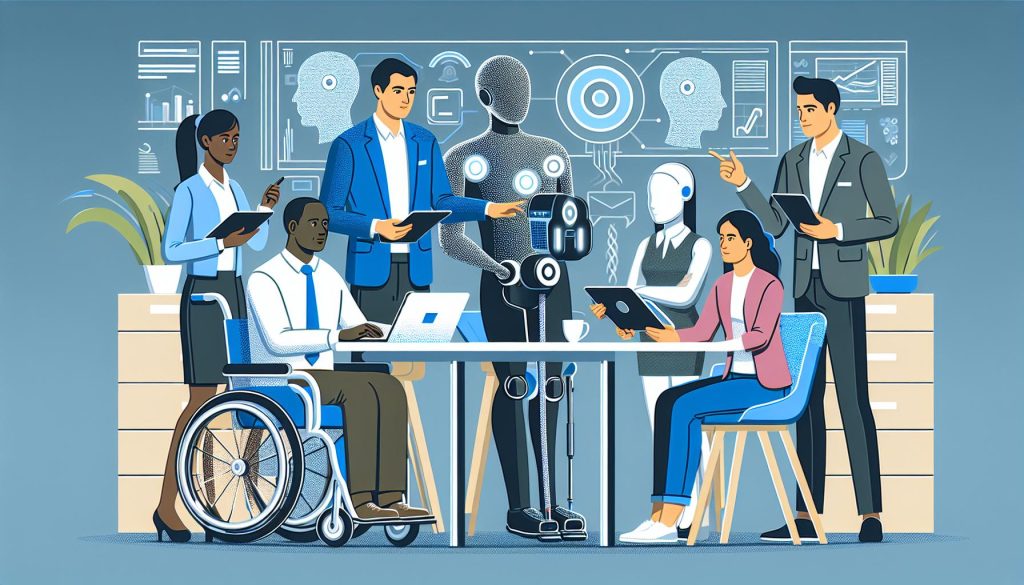In the evolving landscape of healthcare, an innovative frontier has emerged, capturing the imagination of professionals and technologists alike: prompt engineering. This niche, yet rapidly expanding field, promises to revolutionize how healthcare data is interpreted, managed, and utilized, offering unprecedented opportunities for enhancing patient care and operational efficiency. At its core, prompt engineering involves crafting queries that guide artificial intelligence systems to generate useful, accurate responses. This technique is not just about programming; it’s about understanding the nuances of human language and the complexities of medical information to bridge the gap between vast data repositories and actionable insights.
As healthcare organizations navigate the challenges of integrating advanced technologies into their workflows, the role of prompt engineers becomes increasingly vital. They’re the architects designing the prompts that enable AI to sift through medical literature, patient records, and research data, transforming these into comprehensible, relevant information for clinicians and researchers. The real-world applications of prompt engineering in healthcare are as diverse as they are impactful, from improving diagnostic accuracy to personalizing patient care plans. This introduction peels back the curtain on a field that stands at the intersection of technology and medicine, inviting readers to explore the profound implications of prompt engineering in reshaping healthcare as we know it.
The Evolution of Prompt Engineering in Healthcare
Prompt engineering in healthcare has transitioned from a novel idea to a foundational technology, improving the ways in which medical professionals and AI systems interact. Initially, the focus was on leveraging artificial intelligence to manage vast amounts of data. However, the challenge of extracting relevant and accurate information led to the development of sophisticated prompt engineering techniques.
Early attempts at utilizing AI in healthcare revolved around basic data analysis and pattern recognition in patient records, but these efforts often resulted in incomplete or irrelevant information retrieval. Recognizing the need for more nuanced interactions with AI, researchers and technology developers began experimenting with prompt engineering as a means to refine data queries and improve the quality of responses.
This evolution saw the incorporation of natural language processing (NLP) technologies, enabling more complex and contextually aware prompts. These advances allowed AI systems to understand and respond to queries with greater precision, making them more useful in clinical decision-making processes. For instance, prompts can now guide AI in sifting through medical literature to find specific research outcomes, analyze patient records to identify trends or anomalies, and even suggest personalized treatment plans based on individual patient data.
The roles of prompt engineers have become increasingly critical in this landscape, leading to the emergence of specialized prompt engineering careers and jobs within the healthcare sector. These professionals work closely with medical experts to design and refine prompts that maximize the AI’s utility while ensuring that the extracted information is accurate, relevant, and trustworthy.
Furthermore, the integration of prompt engineering in healthcare has facilitated real-time decision support, predictive analytics, and personalized patient care, showcasing a remarkable journey from simple data management to complex, AI-driven healthcare solutions.
As healthcare continues to evolve, the role of prompt engineering stands as a testament to the pivotal intersection of AI technology and medical expertise, continually transforming patient care and medical research.
Key Applications of Prompt Engineering in the Healthcare Sector

Prompt engineering in healthcare leverages natural language processing to revolutionize how medical professionals interact with AI systems, enhancing decision-making and patient care. This section elaborates on the pivotal applications of prompt engineering in the healthcare sector, underlining its role in clinical and administrative tasks.
Diagnosing Medical Conditions
Prompt engineering assists doctors by analyzing patient symptoms and medical histories through AI. By inputting descriptive prompts, healthcare professionals obtain differential diagnoses, streamlining the identification of potential medical conditions. This application not only saves time but also increases diagnostic accuracy, especially in complex cases.
Personalizing Patient Treatment Plans
AI systems, guided by carefully crafted prompts, evaluate patient data, including demographics, medical history, and genetic information, to suggest personalized treatment options. This bespoke approach ensures that treatments align with individual patient needs, improving outcomes and enhancing patient satisfaction.
Streamlining Administrative Tasks
In the realm of healthcare administration, prompt engineering simplifies tasks such as scheduling appointments, managing patient records, and processing insurance claims. By automating these processes, healthcare facilities reduce administrative burdens, allowing staff to focus on patient-centric responsibilities.
Enhancing Drug Discovery and Development
Researchers utilize prompt engineering to analyze vast datasets of chemical compounds and biological data, accelerating the discovery of new drugs. This process aids in identifying potential therapeutic candidates faster, significantly reducing the time and cost associated with drug development.
Supporting Mental Health Assessments
AI-powered applications, designed with specific prompts, offer new avenues for mental health assessments, providing therapists and patients with tools for monitoring mental wellness. These applications analyze language and speech patterns to detect signs of stress or depression, facilitating early intervention.
Prompt engineering in healthcare not only streamlines operational efficiencies but also plays a crucial role in improving patient outcomes. Its applications, from diagnosing medical conditions to supporting mental health assessments, underscore the transformative potential of AI in healthcare. As prompt engineering continues to evolve, it paves the way for more personalized, efficient, and effective healthcare services, reinforcing its importance in contemporary medical practices.
Benefits of Prompt Engineering for Healthcare Professionals

Prompt engineering offers several advantages to healthcare professionals, enhancing their ability to diagnose, treat, and manage patient care through the integration of advanced AI technologies.
- Improves Diagnostic Accuracy: By leveraging natural language processing (NLP) and sophisticated prompt engineering techniques, healthcare professionals can access AI-driven diagnostic tools. These tools can interpret symptoms and medical history with a high degree of accuracy, helping to reduce diagnostic errors.
- Facilitates Personalized Treatment Plans: With prompt engineering, AI systems can analyze patient data, including genetic information and lifestyle factors, to suggest personalized treatment options. This allows for more tailored and effective care strategies, improving patient outcomes.
- Streamlines Administrative Tasks: Healthcare professionals often face a significant burden of administrative tasks, such as documentation and scheduling. Prompt engineering can automate many of these processes, freeing up time for patient care and reducing the risk of burnout.
- Enhances Drug Discovery and Development: The AI systems, guided by prompt engineering, can process and analyze vast amounts of research data at an unprecedented speed. This accelerates the pace of drug discovery, making it quicker and more cost-effective to bring new treatments to market.
- Supports Mental Health Assessments: Prompt engineering enables the development of AI tools that can assist in the assessment of mental health conditions. By analyzing patient responses and behavior, these tools can offer insights into a patient’s mental state, supporting early intervention and ongoing care management.
In the context of healthcare, the benefits of prompt engineering extend beyond operational efficiencies to directly impact patient care and treatment outcomes. As prompt engineering continues to evolve, its role in supporting healthcare professionals in delivering high-quality care is becoming increasingly essential.
Challenges and Considerations
In the realm of healthcare, implementing prompt engineering presents unique challenges and considerations. Despite its transformative potential, ensuring the efficiency and ethical application of this technology requires careful reflection and strategy.
Data Privacy and Security
One of the foremost concerns is data privacy and security. Healthcare organizations handle sensitive personal health information (PHI) which must be protected under laws like HIPAA in the United States. Prompt engineering involves processing vast amounts of data, necessitating robust encryption and secure data handling practices to prevent breaches and ensure patient confidentiality.
Bias and Accuracy
Bias in AI systems is a critical issue, as it can lead to misdiagnoses or unequal treatment recommendations. Data used in prompt engineering must be diverse and expansive to minimize bias. Moreover, the accuracy of information extracted or generated by AI is paramount, as errors can have dire consequences in clinical settings. Developers must continually refine algorithms and validate their outputs against expert knowledge and the latest medical research.
Interoperability
Healthcare systems are complex and fragmented, making interoperability a significant challenge. Prompt engineering solutions must seamlessly integrate with existing electronic health records (EHR) systems and fit within clinicians’ workflows. Ensuring that AI-generated prompts and responses can communicate effectively with various healthcare databases and software is essential for widespread adoption.
Regulatory Compliance
Healthcare is a heavily regulated industry. Any application of prompt engineering must comply with regulatory standards governing medical devices and software. Navigating these regulations while innovating poses a delicate balance for developers, requiring deep industry knowledge and legal expertise.
Skill Gap
The specialized nature of prompt engineering in healthcare creates a skill gap. Healthcare organizations may struggle to find professionals with both the technical proficiency in AI and an understanding of medical science. Bridging this gap demands targeted education and training initiatives, as well as collaborations between medical professionals and AI experts.
By addressing these challenges and considerations, the healthcare industry can harness the full potential of prompt engineering to revolutionize patient care while maintaining ethical standards and operational integrity.
Future Directions for Prompt Engineering in Healthcare
The trajectory for prompt engineering in healthcare promises to reshape patient care, healthcare delivery, and medical research significantly. As this field matures, prioritizing the development of more sophisticated prompts that can interact seamlessly with AI to process natural language more effectively becomes paramount. This improvement will likely foster a deeper understanding of patient needs and medical contexts, leading to more accurate diagnoses and personalized treatment plans.
Expanding the scope of prompt engineering to cover a broader range of healthcare applications is another direction. This expansion could include more nuanced mental health assessments, predictive analytics for patient health outcomes, and enhanced monitoring of chronic conditions. By doing so, prompt engineering will not only improve the current healthcare practices but also introduce new methods for preventive care and continuous health monitoring.
Addressing the challenges of data privacy and bias will continue to be critical as prompt engineering evolves in healthcare. Innovations in encryption and anonymization techniques will be necessary to protect sensitive patient information, while more inclusive data sets will help minimize bias in AI-generated insights and recommendations. Moreover, ensuring interoperability with existing health systems will facilitate a smoother integration of prompt engineering technologies, maximizing their utility and adoption in clinical settings.
The demand for professionals skilled in prompt engineering is expected to rise, reflecting its growing importance in healthcare. Careers in this field will likely expand, encompassing roles focused on developing, implementing, and managing AI systems driven by advanced prompts. As such, educational programs and training opportunities dedicated to prompt engineering will become more prevalent, equipping a new generation of professionals with the necessary skills to innovate in healthcare.
As prompt engineering continues to advance, its applications in healthcare will become more diverse and impactful. This progress will necessitate a concerted effort from professionals across healthcare and technology sectors to navigate the challenges and exploit the opportunities that prompt engineering presents, ultimately enhancing patient care and health outcomes.
Conclusion
As the healthcare industry continues to evolve, so too does the role of prompt engineering in enhancing patient care. By refining the interaction between medical professionals and AI systems, it’s become a pivotal technology in diagnosing conditions, personalizing treatments, and supporting mental health. However, the journey doesn’t end here. Overcoming challenges like data privacy and bias is crucial for its successful integration. With ongoing advancements and collaborative efforts, the potential of prompt engineering in healthcare is boundless, promising a future where technology and human expertise converge to deliver unprecedented levels of patient care.

